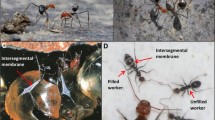Abstract
Cyclical oligogyny is considered to be the mechanism that is most likely to be responsible for stabilizing cooperation in polygynous, epiponine wasps, in which single-queen colonies produce new queens and multiple-queen colonies produce males. In contrast with the number of studies on relatedness among adult females, we know little about relatedness among males in polygynous epiponine wasps. We estimated worker and male relatedness in the Brazilian epiponine wasp Polybia paulista Ihering and found that colonies of P. paulista produced males when they contained multiple queens. Although average relatedness within males did not differ significantly from 0.5, the number of alleles observed suggests that there were more than one queen to produce males in each colony. Our data would be helpful to elucidate dynamics of the male production in a colony of epiponine wasps.

Similar content being viewed by others
References
Bassam BJ, Caetano-Anolles G, Gresshoff PM (1991) Fast and sensitive silver staining of DNA in polyacrylamide gels. Anal Biochem 196:80–83
Goodnight KF, Queller DC (1995) Relatedness 4.2. Goodnight Software, Texas, Houston
Hamilton WD (1964) The genetical evolution of social behaviour. J Theor Biol 7:1–52
Hastings MD, Queller DC, Eischen F, Strassmann JE (1998) Kin selection, relatedness, and worker control of reproduction in a large-colony epiponine wasp, Brachygastra mellifica. Behav Ecol 9:573–581
Henshaw MT, Strassmann JE, Quach SQ, Queller DC (2000) Male production in Parachartergus colobopterus, a neotropical, swarm-founding wasp. Ethol Ecol Evol 12:161–171
Hughes CR, Queller DC, Strassmann JE, Solís CR, Negrón-Sotomayor JA, Gastreich KR (1993) The maintenance of high genetic relatedness in multiple-queen colonies of social wasps. In: Keller L (ed) Queen number and sociality in insects. Oxford University Press, Oxford, pp 153–170
Kudô K, Yamane S, Mateus S, Tsuchida K, Itô Y, Miyano S, Zucchi R (2004) Parasitism affects worker size in the Neotropical swarm-founding social wasp, Polybia paulista (Hymenoptera, Vespidae). Insectes Soc 51:221–225
Kudô K, Tsujita S, Tsuchida K, Goi W, Yamane S, Mateus S, Itô Y, Miyano S, Zucchi R (2005a) Stable relatedness structure of the large-colony swarm-founding wasp Polybia paulista. Behav Ecol Sociobiol 58:27–35
Kudô K, Ishiguro N, Tsuchida K, Tsujita S, Yamane S, Zucchi R (2005b) Polymorphic microsatellite loci for the swarm-founding wasp, Polybia paulista (Hymenoptera: Vespidae). Entomol Sci 8:5–7
Noll FB, Zucchi R (2000) Increasing caste differences related to life cycle progression in some neotropical swarm-founding polygynic wasps (Hymenoptera: Vespidae: Epiponini). Ethol Ecol Evol 12:43–65
Queller DC (1993) Genetic relatedness and its components in polygynous colonies of social insects. In: Keller L (ed) Queen number and sociality in insects. Oxford University Press, Oxford, pp 132–152
Queller DC, Goodnight KF (1989) Estimating relatedness using genetic markers. Evolution 43:258–275
Queller DC, Strassmann JE, Solís CR, Hughes CR, DeLoach DM (1993) A selfish strategy of social insect workers that promotes social cohesion. Nature 365:639–641
Strassmann JE (2001) The rarity of multiple mating by females in the social Hymenoptera. Insectes Soc 48:1–13
Strassmann JE, Gastreich KR, Queller DC, Hughes CR (1992) Demographic and genetic evidence for cyclical changes in queen number in a neo-tropical wasp, Polybia emaciata. Am Nat 140:363–372
Strassmann JE, Solís CR, Hughes CR, Goodnight KF, Queller DC (1997) Colony life history and demography of a swarm-founding social wasp. Behav Ecol Sociobiol 40:71–77
Strassmann JE, Goodnight KF, Klingler CJ, Queller DC (1998) The genetic structure of swarms and the timing of their production in the queen cycles of neotropical wasps. Mol Ecol 7:709–718
Trivers RL, Hare H (1976) Haplodiploidy and the evolution of the social insects. Science 191:249–263
West-Eberhard MJ (1978) Temporary queens in Metapolybia wasps: nonreproductive helpers without altruism? Science 200:441–443
Acknowledgments
This study was supported in part by Research Fellowships of the Japan Society for the Promotion of Science (JSPS) for Young Scientists to K. Kudô (no. 02415) and the JSPS Fellowships for Research Abroad to K. Kudô. We thank two anonymous referees who made invaluable comments and suggestions for the improvement of the text.
Author information
Authors and Affiliations
Corresponding author
Additional information
Edited by Fernando B Noll – UNESP
Rights and permissions
About this article
Cite this article
Kudô, K., Sugawara, S., Shinohara, K. et al. Estimates of Genetic Relatedness Among Males in a Polygynous Wasp. Neotrop Entomol 42, 137–140 (2013). https://doi.org/10.1007/s13744-012-0098-9
Received:
Accepted:
Published:
Issue Date:
DOI: https://doi.org/10.1007/s13744-012-0098-9




